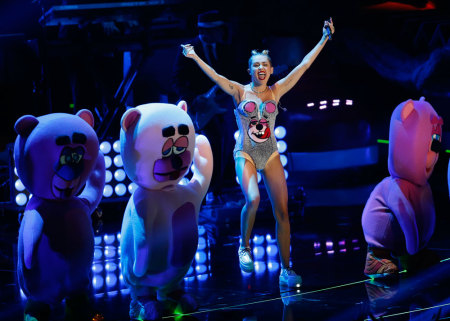Is the '1950s Remake of Miley Cyrus' 'We Can't Stop' Better Than the Original? YouTube Viewers Think So

A week after Miley Cyrus' VMA antics captivated headlines and horrified millions – among them Will Smith – a viral video took her infamous song "We Can't Stop" back to the 1950s, and received a more positive response.
The 1950's remake, published Sept. 3, has been viewed 3.6 million times in the past week, and has 8,542 comments.
While Miley Cyrus' original music video attracted 184 million hits, only slightly more than half (52%) of the voters "liked it," while a whopping 96.6% of viewers expressed support for the 1950s version. The most watched YouTube video of Cyrus' VMA performance, by contrast, received only 16% approval.
"Class > A**. Take notes, Miley," wrote YouTube profile Perfhex in a crude but precise comment on the remake, which held the top spot at 31 "likes." The second-place comment, with 16 votes of support, belonged to Maryam Hajiyeva – "better than miley!" Upwards of fifty comments called it "better than the original."
While the video doesn't alter Cyrus' scandalous lyrics, it does put a modest spin on a song so bombastic it is already said to have "made history."
The band behind the throwback, Postmodern Jukebox, plays a new twist on hip hop – transforming songs like Carly Rae Jepsen's "Call Me Maybe" and Ke$he's "Die Young" into all different styles – Country, Motown, 1920s jazz, and, for "We Can't Stop," 1950's Doo Wop.
Doo Wop, a vocal-based genre mixing rhythm and blues, allegedly fit the song well. The throwback sound of piano, upright bass, drum set and background vocalists may do the song more justice than Cyrus' synths. The lead vocalist gave a cleaner and less rebellious tone to the melodramatic teenage lyrics of "We Can't Stop." Her smooth voice still included such lewd lyrics as "to my home girls here with the big bu**s/shaking it like we at a strip club," but the entire feel of the song shifted from angsty rebellious pop to classic R&B.
The video, too, proved a remarkable contrast. Cyrus' steamy music video accentuated the curves of women's bodies and included a dollar bill sandwich, a French fry skull, and dancing life-size teddy bears. The 1950's version features a classy rock-and-roll band, singing and playing naturally.
"Growing up as an aspiring jazz pianist, I wasn't interested in listening to anything that might appeal to those that I deemed to possess a less than refined palette of musical taste," Postmodern Jukebox founder Scott Bradlee wrote on the band's website. Later on, however, Bradlee had a change of heart, and embraced pop music.
Nevertheless, his old jazz days continued to inform his perspective on modern hip hop. "I found that by simply altering the context of such songs, I could find quite a bit of artistic merit inside them," he explained. Fitting songs like "We Can't Stop" into different musical genres opened up possibilities and enabled him to appreciate them more.
"My goal with Postmodern Jukebox is to get my audience to think of songs not as rigid, ephemeral objects, but like malleable globs of silly putty," he wrote. "I want to create an alternate universe of popular song."





















